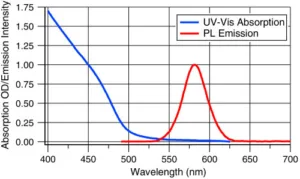According to a post by quantum dot consultant, Peter Palomaki, Osram has acquired quantum dot developer, Pacific Light Technologies (PLT). Requests to confirm the deal to PLT went unanswered but Osram did confirm the purchase. Personnel for PLT’s Linkedin page shows a change in company affiliation to Osram Opto-Semiconductor last December. Plus, Palomaki says he has seen advertisements for quantum dot chemists to work for Osram in the Portland area where Pacific Light Technologies (PLT) has been located (and there are no known Osram facilities there).
We asked Osram what their plans are for with PLT in terms of integrating quantum dots into LED devices and when a green quantum dot solution would be available. They reply was a pretty unsatisfying, “that is still part of our research and development activities.”
PLT’s focus has been on placing quantum dots directly on an LED for lighting applications. They have published papers on this over the last few years. A recent paper describes the use of a red quantum dot in an LED for lighting applications, but the technology should be useful for displays as well.
The big problems with placing quantum dot directly on an LED (typically blue) are the very high flux levels. This creates stability issues for the quantum dots at these high temperatures as well as the self absorption problem. This latter is a problem because there is an overlap between the absorption spectrum and the emission spectrum. In other words, red or green photons that are emitted can be quickly absorbed, decreasing efficiency and light output. PLT claims to have solved these problems, however, by engineering a stable QD with minimal overlap. (the avoidance of this overlap is a significant factor in the development of the Philips ColorSpark HLD LED projector light source technology – Man. Ed.) The figure below from this latest paper shows the results for their red quantum dot.
PLT says that their QDs are produced as powders so that they can be included with other phosphor materials, like YAG, and embedded in silicon resin to fit into standard manufacturing workflows.
It should be noted that this red quantum dot is based on a CdSe material. Use of cadmium is a concern to many and depending upon its concentration, an LED using it may not meet RoHS requirements. PLT says current concentrations are in the 150 to 500 ppm range, thus exceeding the 100 ppm limit for RoHS compliance. The exemption for this compliance is currently in discussion, but many feel it will not be renewed. (and several vendors, including Apple and Samsung, are committed to avoiding cadmium even if there is an exemption – Man. Ed.).
On the other hand, InP based quantum dots are much more sensitive to air and moisture. To date, PLT is not aware of any InP-based QDs that can be used on-chip.
Apparently, Lumileds has been using this red QD material in an LED device since it was announced in March 2016. However, it was only recently that the use of a red QD from PLT was revealed. The Luxeon 3535L HE Plus is for lighting applications so the spectrum is not well balanced for a display application, but it certainly demonstrates that red CdSe-based quantum dots can be placed on chip for potential display use – if CdSe is acceptable – a big if.
The paper also discussed the use of QDs in displays noting that to achieve better coverage of the BT.2020 color gamut, quantum dots with a more narrow spectrum will be needed. They also note that Cd-based QDs have a more narrow spectrum and can achieve better results – something we have known for awhile, but appears to be a non-starter in the Western TV market (maybe not for China).
Palomaki also raised an interesting question in his post. With Osram now owning PLT, what happens to the Lumileds LED using the red QD from PLT? I am sure there is an internal answer, but realistically, this is only one LED in a lineup of hundreds. I doubt Lumileds will miss it.
He also wonders if and when a green QD on chip solution will emerge. We are all wondering that.
Perhaps the more interesting question is what does Osram plan to do with this technology? – CC

